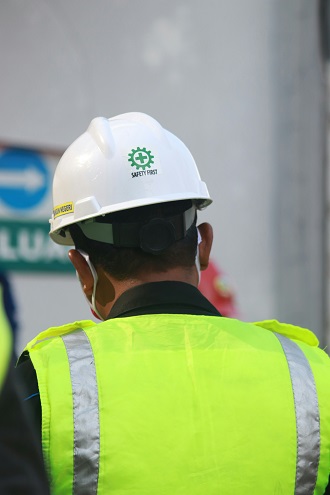
Originally Published by Cole Publishing
Nearly all worksite injuries and fatalities are preventable. John Brengosz, Loss Control Consultant for R & R Insurance, says one way to prevent workplace incidents is to determine the underlying causes and correct them. This requires a thorough incident investigation.
“Ideally, we would want to prevent somebody from getting injured. But at the very least, we want to learn from an injury so it doesn’t happen again and again,” Brengosz says.
Prepare a Response Strategy
OSHA encourages organizations to investigate all worksite incidents that result in injuries, plus close calls in which workers escape injury. Organizations are required to notify OSHA within 24 hours when incidents involve an amputation, loss of an eye, or admittance to a hospital.
Conducting a thorough incident investigation requires forethought. Injuries can occur at the most inconvenient times, so organizations should prepare an incident-response strategy in advance. Brengosz recommends developing several topic areas and questions based on the types of injuries that typically occur. Using this list, organizations are prepared to gather information, even in hurried or stressful situations.
In addition to this list, organizations also should fill out a standard incident investigation form. The form should include the injured employee’s name, time and date of the incident, department, and description of the incident.
“We don’t need to know the (employee’s) birth date, the hire date, or the rate of pay, for it has nothing to do with how this person got hurt,” Brengosz says. “We wasted a whole bunch of time just filling in boxes, and we haven’t even gotten to the investigation.”
Question Witnesses
Brengosz recommends investigating an incident as soon as possible, after medical care is provided, but while the incident is fresh in the minds of the people involved.
“You have to go out and talk to people and look at the scene as soon as you can,” he says. In addition to interviewing the worker involved in the incident, investigators also should interview witnesses.
“I rarely see any witness statements when reviewing completed investigations,” Brengosz says. “Maybe it’s a case that, ‘We’ve had enough.’ By the time we talk to the injured party, we think we’ve already ‘wasted too much time on this’ and just want it to be done. I understand that. I don’t like it, but I get it.”
A supervisor or lead person should complete the investigation report, not Human Resources or a Safety Committee, Brengosz says.
“Those folks can answer questions or help that person do the investigation, but it really should be the supervisory person to take responsibility for the injury and the fix,” Brengosz says.
Ask For the Injured Employee’s Account
In addition to answering the supervisor’s questions, injured employees should write their own version of the incident as a stand-alone document.
“It’s good to get their unfiltered description of how they were injured in case the story changes two years from now when we’re at a work comp hearing,” Brengosz says. Realistically, the supervisor’s and employee’s descriptions of the incident should be a close match.
“If not, you have to go back to the drawing board, and there’s more work to do,” he says.
Investigations can be tricky if the injured employee or the supervisor broke a safety rule or operational rule. They won’t necessarily jump in and admit it.
“The best way to address that is to have other people reviewing the completed reports,” Brengosz says.
Conversate, Don’t Interrogate
He tells supervisors to take a friendly approach when conducting an incident investigation.
“It’s way more effective if the supervisor can make it a conversation and not an interrogation,” he says.
He also suggests recording the interview, as long as the employee agrees to being recorded. A recording allows for a free-flowing conversation. It also creates an audio file that can be reviewed by others in the future. The conversation should begin with the employee describing what occurred. Afterwards, the interviewer can ask questions and gather details.
“If you’re just talking to them and having a discussion and asking questions, you don’t have to spend all this time writing things down and potentially missing important things that they’re saying,” Brengosz says, referring to the benefits of a recorded interview.
Avoid Sarcasm, Blame & Threats
Brengosz recommends using a tone of voice and mannerisms that invite employees to open up.
“Go in with the attitude of ‘We’re not doing this to trap you. We’re really doing it to find out what happened,’” Brengosz says. Avoid sarcasm, blame, and threats. Instead, investigators can encourage collaboration by asking employees for solutions: “What are your ideas to prevent this from happening again?”
“That gives them a chance to weigh in, too,” Brengosz says.
If investigators don’t think employees are being completely truthful, Brengosz recommends revisiting the facts.
“If the story changes, use tact and try to clear that up,” he says.
Get Everyone Involved to Review
In addition to filling out reports, investigators should take photos and videos to document the conditions at the work site.
Once the initial investigation concludes, the next step is a management incident review. The injured employee, supervisor, safety committee rep and human resources rep should meet with a high-ranking person in the company.
“I’m a huge fan of letting top management see those reports so they know what’s going on and also what we’re doing to stop the constant repeat of the same injuries,” Brengosz says. “I think it’s important for people working for your organization to know that you’re diving into this stuff and solving it.”
After reviewing the incident together, the management group should discuss what changes and training need to occur. Brengosz also recommends that safety committees review the incident investigation reports.
“Maybe somebody in that safety committee has seen a similar type of an injury or situation. They might know something that nobody else knew or realized to help the situation,” Brengosz says. “I don’t think this gets done enough.”
Learn and Take Action
The final step in the incident investigation process is to learn something from the incident and take corrective action.
“Don’t complete these reports, throw them in a file, and they never see the light of day again,” Brengosz says.
Although it’s easy to blame the incident on carelessness or failure to follow a rule, it’s better to determine the underlying causes of an incident. Then, identify what changes need to be made to prevent further incidents.
“It’s very common for me to see an organization that has all sorts of injuries related to lifting and material handling. I will ask them, ‘Hey, do you do training on material handling, lifting, use of hoists, etcetera?’” Brengosz says.
Accidents Are Costly
Preventing incidents from happening is a key to productivity and job satisfaction. A safe workplace also saves an organization money. Accidents can be costly. Brengosz estimates that organizations paying $1,000 for a worker’s compensation claim actually pay double in other “hidden” costs.
Organizations can demonstrate their commitment to workers’ health and well-being by maintaining a safe workplace, prioritizing safety training, and thoroughly investigating incidents. Incident investigations help organizations determine the root causes of an incident, so they can develop solutions that prevent the incident from recurring.



